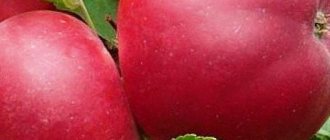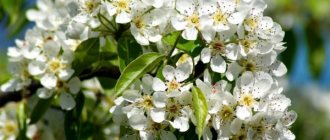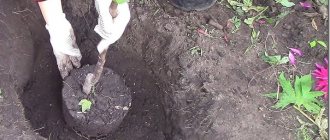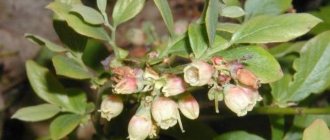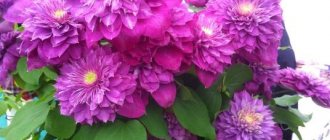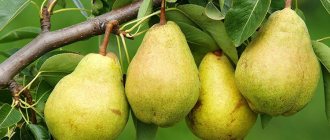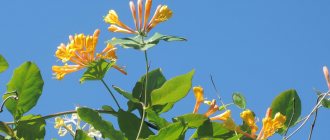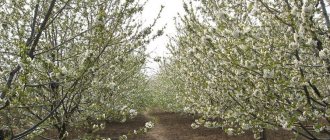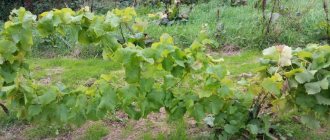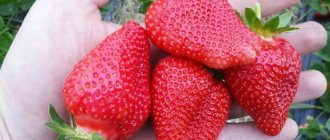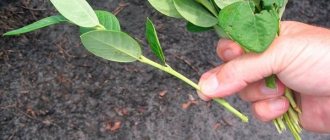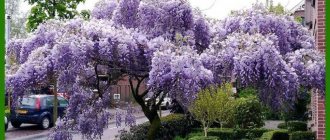What type does it belong to?
This apple variety was created in America and became widespread thanks to its fruits.
The Long (Kitayka) variety is an early autumn variety of apples.
Apples of this variety have amazing taste, and Dolgo fruits also have an amazing dessert aroma.
Mature trees are abundantly hung with fruits, most often small in size, bright red in color.
This gives the tree a special elegance.
Ranetka apple trees: the best varieties (video)
Ranetka variety "Ranetka Raspberry"
A very winter-hardy variety. Fruiting occurs two years after planting in a permanent place. The harvests are stable and annual. The apple tree produces fairly small fruits, the weight of which does not exceed six grams. Apples at the ripening stage have a round-conical shape, dark crimson skin with a noticeable bluish bloom.
The fruit pulp, dense in consistency, is characterized by juiciness, pinkish color and sweetish-sour taste. Mass ripening of fruits occurs in the first half of September. Apples have good shelf life and are perfectly preserved for six months. The fruits are used mainly for processing.
Ranetka variety "Ranetka Yantarnaya"
Many gardeners know apple trees of this variety under the name “Altai Yantarka”. The variety has excellent winter hardiness and durability. The trees are very tall, and fruiting begins in the fourth year of cultivation. Productivity is high and stable.
The apples are small, weighing no more than ten grams. The shape of the fruit is spherical, the ribs are clearly visible, the skin is light yellow. The pulp is yellow, dense, juicy. The taste is sour, with noticeable astringency.
The crown of the tree is wide, very dense and pyramidal. The variety is susceptible to severe scab and moniliosis, as well as apple moth attacks. The harvest ripens after the first ten days of September. The fruits are used for processing.
Description of the variety Long
The Long apple tree will definitely become the center of your garden and will arouse the admiration of others.
The trees are small in size , but tall (about 4 meters).
The crown shape is round and wide. The shoots are medium pubescent, very dark green.
The branches are mostly straight, directed upward. During the ripening period, the branches are completely covered with fruits, supported by a short stalk.
The leaves of apple trees are similar to plum trees. They have an oblong shape, slightly jagged edges. The leaves are wavy, often curled, not pubescent.
The fruits of this variety are small in size, with smooth skin . The weight of one fruit is approximately 20 g. The shape of the fruit resembles a cone, but sometimes spherical ones are also found.
The color of the apples is bright red , the saucer is not pronounced. A small depression with yellowish edges. The pulp is elastic, cream-colored with red specks, sweet and sour .
During long-term storage, the pulp turns yellow.
Description and characteristics of the Berry apple tree species
Berry apple tree (lat. Malus baccata) is an unusual representative of the genus Apple tree of the Rosaceae family, notable for its extremely small fruits. Its homeland is called China, where it grows in the wild. It can also be found in the forests of Mongolia, Eastern Siberia, Korea and even in northern European countries.
This species is actively used in decorating gardens, landscape areas, alleys, and parks. Such a tree looks especially advantageous in the autumn, when most other crops lose their elegant appearance, and it beautifully shimmers with sparkling fruits.
First of all, the appearance of such a tree attracts attention:
- it has a non-standard crown: spherical or umbrella-shaped;
- the leaves have a slightly elongated shape and are painted in a shiny dark green color;
- the older the apple tree is, the more crooked and tortuous its trunk is, due to which an adult tree takes on the appearance of a bush;
- the branches are long, thin, raised upward;
- the bark is gray, but the intra-stem tissues have a beautiful brown-red color, young tree rings are painted a pleasant peach shade. These decorative properties are highly valued in the furniture industry and artistic carvings.
Advantages and disadvantages
- The Berry apple tree has several subspecies, which are characterized by typical benefits:
- high frost resistance;
- undemanding to soil;
- regular fruiting;
- strong immunity;
- compatibility with other apple species and varieties;
- excellent decorative qualities;
- The wood of such apples is excellent for crafts.
- As for the cons, the significant disadvantages are as follows:
- small fruit;
- unsuitability of fresh fruits for food;
- the crown thickens very quickly, and if branches are not pruned in a timely manner, the tree will become vulnerable to fungus.
The berry apple tree is classified as a tree of the third size, since it can reach a height of 10 m. However, at home it is rarely grown above 5 m.
Annual growth
Representatives of this species grow extremely slowly. The growth of green mass and new shoots in an apple tree directly depends on the quality and regularity of fertilizing and watering.
Important! If you follow all the necessary care recommendations, the annual increase will be 5 points, and not the annual increase - 2
Timing of flowering and fruit ripening
In May, small (up to 3 cm) light pink buds appear on the branches of the apple tree. They are collected in inflorescences of 4–8 pieces, which have no smell, but give a festive look to the tree. There are so many flowers on the crown that from a distance it resembles a foam cap. The flowering period lasts from 2 to 4 weeks.
Fruits appear only on trees older than 3 years. In September - October, the crown is decorated with small reddish apples, the size of which rarely exceeds 1 cm. Inside, the fruit is divided by leathery valves into 5 chambers with seeds.
Such apples are tasteless when fresh, so they are practically not eaten, but they look very beautiful as a garden decoration. And due to their small size, these fruits remain on the branches until December.
Did you know? Birds love the apples of this plant, so birds often feed exclusively on them in winter.
Productivity
The small-fruited Berry apple tree bears fruit regularly, if weather conditions permit. It is characterized by high productivity, and most owners of such a tree use its fruits only as garden decorations.
However, some housewives have adapted to making wonderful jam from small apples. After heat treatment, the fruits retain their shape and acquire a beautiful honey color.
Winter hardiness and disease resistance
The species in question is highly frost-resistant, so it does not require special preparation before cold weather. Some of its varieties, bred for northern regions, are able to withstand temperatures down to -56°C.
Did you know? The Berry apple tree is considered the most winter-hardy species of the Apple genus in the world.
This plant also has high immunity. If you timely fertilize the soil, ensure regular watering and high-quality crown formation, the tree will independently resist any diseases.
Photo
History of variety selection
The Chinese Long apple tree was obtained in America in 1917 by the scientist Hansen . Sibirka were taken as a basis .
Thanks to their amazing beauty and frost resistance, apple trees of this variety have become widespread as ornamental varieties in Western, Eastern and Northwestern Siberia.
When crossing varieties, the well-known hybridization method was used.
Of the 15 experimental mother trees, pollen for re-pollination was collected from only 11.
After successful re-pollination, Hansen was able to breed the seeds of a new variety.
Before the upcoming planting, the breeder subjected the seeds to stratification. This process took him 4 months.
The planting was successful, and in the future, when caring for the new variety, the mentor (educator) method was used. The variety underwent its “baptism” in harsh conditions, which allowed it to develop good frost resistance.
Advantages and disadvantages
Looking at the photo of the decorative apple tree for a long time, we can conclude that it is quite beautiful to look at and will become a real decoration of the garden.
In addition, Chinese Long has other advantages, such as:
- resistance to many diseases and the adverse effects of pests;
- high productivity;
- frost resistance, which allows trees to be planted in countries with different climates;
- annual fruit-bearing;
- no shedding of apples.
But there are also several disadvantages:
- The maximum shelf life of fruits is 2 months.
- Apples are small in size.
- Not everyone will like the taste of the fruit.
It is not necessary to use the Chinese Long apple tree just for growing. It will be a wonderful decoration for any garden, which is already a significant advantage.
Region of origin
The region of natural growth in Europe is cold lands. This is mainly Western and Eastern Siberia with its continental climate.
The Long (Chinese) variety is ideal for growing in harsh winter conditions.
Its root system is located deep enough , which allows the tree to maintain optimal temperature.
The variety adapts quite well to hot and dry regions , but the main condition for adaptation is abundant watering.
With insufficient watering, the tree's root system begins to deplete, which in turn leads to a decrease in the accumulation of nutrients and a deteriorated photosynthesis process.
It is in connection with this that the harvest volume decreases.
Suitable varieties for planting in these regions include: Zavetnoye, Isetskoye, Renet Chernenko, Carpet, Lada, Gift for Gardeners, Pepin Shafranny, Ural Bulk, Flashlight, Screen, Yantar, Uralets, Phoenix Altaisky, Daughter of Pepinchik, Lyubava, Gornoaltayskoe, Hornist, Altynai.
Harvest and storage
The harvest from Kitayka can be harvested from August to the end of September. The yield of all varieties is different, but most often it is high, from 40 to 150 kg per tree. Full fruiting begins at 5-8 years of tree life. Some varieties can be stored in the refrigerator until January. They tolerate transportation well.
The world-famous jam is prepared from the fruits of Kitayka. They are used to make candied and dried fruits, jams and mousses, juices and compotes, cider and wine.
Productivity
The productivity of this variety in almost any conditions is quite high , but more often this variety is used as an ornamental tree.
The tree begins to bear fruit approximately 5 years after planting in the ground. The size of the fruit is small, the weight of a mature fruit reaches 15-20 g.
The peculiarity of apples of this variety is their location on the branches; during the ripening period, they densely stick to all the branches, but hold on quite tightly.
The harvest period falls at the end of August - beginning of September ; fruiting of this variety usually occurs once a year.
Apples of this variety are more decorative, so they are not preserved very well.
The only optimal storage location is dark and cold. The combination of these conditions will allow you to preserve apples for 2 months.
The following varieties have good yields: Augusta, Gala, Antonovka dessert, Papirovka, Grushovka winter, Chudnoe, Welsey, Solnyshko, Stroevskoe, Sokolovskoe, Antey, Malinovka, Yablochny Spas, Lobo, Belyi Naliv, Zvezdochka, Elena, Zhigulevskoe, Korey, Uslada.
Features of ripening and fruiting
Fruit harvesting, depending on the growing region, begins in the last summer month. In some areas it can even last until the end of September. Fruiting is abundant, but the apples are very small in size. You can collect up to 170 kg of fruit from one apple tree, and this is not the largest figure. The shelf life of fruits is short, apples are excellent for various technical needs. They are used to make preserves, jams, wine and even spiced cider.
Fruiting begins in the third year after planting. But there are some nuances that are important to consider. To ensure abundant fruiting, you will need to properly care for the apple tree, prune and fertilize it. It is possible to increase the weight of fruits if you correctly normalize the number of ovaries and remove excess ones.
The Kitayka Long apple tree is most often grown as an ornamental apple tree. It looks attractive both in spring and autumn, when the fruits are already ripe and stay on the branches for a long time. Often gardeners leave them on the branches so that hungry birds can feast on them. Many people also love the taste of fruits touched by frost.
Planting and care
Before planting an apple tree, you should finally decide on the place in which it will feel as comfortable as possible.
Preparatory work for planting this variety should begin a week in advance. During this period, it is necessary to prepare holes for planting (no more than 90 cm in depth) and fertilize them.
Within a week, the soil in the holes will have time to warm up and become saturated with fertilizers.
Trees with a closed root system can be planted from late March to mid-April, and in the fall - from late September to late October .
While bare-root apple trees should be produced in the spring (from mid-April to mid-May) or in the fall (from mid-September to mid-October).
TIP: this variety of apples will feel good alone, do not place them close to other trees. The Long Chinese apple tree will look good in the center of the garden composition.
Proper care for apple trees of the Long (Chinese) variety includes a certain sequence of actions:
- The tree needs regular inspection.
- If necessary, mandatory healing of visible wounds.
- Every spring, remove dry and damaged branches.
- In spring and summer, the soil around the tree must be loosened and cleared of weeds.
- The apple tree needs abundant watering.
- If necessary, apple trees need to be sprayed against pests.
This simple combination of actions will help turn your apple tree into the real pride of your orchard!
Chinese apple tree - care
An unpretentious and frost-resistant small-fruited tree tolerates frosty winters well, so special measures in most areas for shelter are not required. All basic procedures during the warm period differ little from caring for simple varieties. Let's look at the main points on how to grow a Chinese apple tree:
- Periodic watering in hot weather without precipitation. It is recommended to pour 30-50 liters of water onto the tree up to 5 times a season.
- Treating the crown with insecticides against insects. The drugs are suitable: Fitoverm, Iskra, Fufanon, Intavir, Aktara,
- Not all varieties are equally resistant to scab and other infections. In unfavorable years, Kitayka requires spraying with fungicides - “Horus”, copper sulfate, “HOM”, “Fitosporin”.
- If there is a risk of damage to the trunk by rodents in the fall, the trees are wrapped underneath with metal mesh, roofing felt, or plastic.
- Autumn whitewashing of the trunk and skeletal branches with lime.
- Loosening the standard circle and removing weeds.
- Fertilizing the tree trunk circle with complex preparations - nitroammophoska 30-40 g or organic matter (humus, herbal infusion).
Chinese apple tree pruning scheme
The main goal of annual thinning of branches is to obtain a healthy, translucent and orderly crown. Any variety of paradise apples during the dormant period before the start of the growing season for normal development requires the following care:
- Removing dried and damaged branches.
- Cutting out growth growing inside the crown.
- Pruning diseased growth.
- Thinning out crossing and rubbing shoots.
- Removal of low and vertically growing branches on mature trees.
- Formation of the crown according to the chosen type - round, spreading, weeping, pyramidal.
